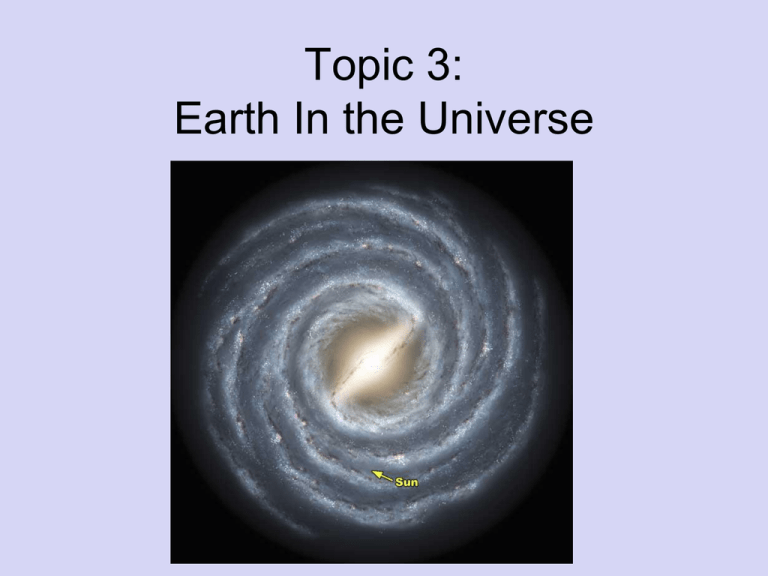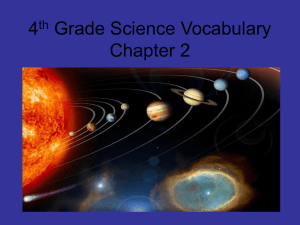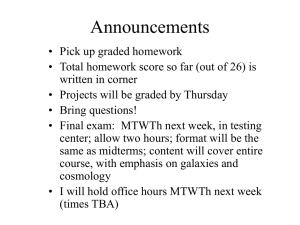Electromagnetic Energy
advertisement

Topic 3: Earth In the Universe Electromagnetic Energy • Celestial objects – any object outside Earth’s atmosphere Electromagnetic Energy • Electromagnetic Energy – energy that is given off from all objects not at absolute zero (0K or -273oC) Type of EM depends on wavelength of energy Electromagnetic Energy • Electromagnetic Spectrum – model that shows all the types of EM in order according to wavelength (ESRT pg 14) Electromagnetic Energy Electromagnetic Energy • Each element emits energy in specific wavelengths We can tell what elements celestial objects are made of by looking at the wavelengths that they emit Example: Mercury 4 5 6 7 Doppler Effect • Doppler Effect – when the EM wavelengths given off by an object change because the object is moving Doppler Effect Red shift – when the object is moving away Causes the wavelengths to get longer Spectral lines move closer to the red end of the spectrum – Pattern of lines remains the same Doppler Effect 4 5 6 7 Doppler Effect Blue shift – when the object is getting closer Causes the wavelengths to get shorter Spectral lines move closer to the blue end of the spectrum – Pattern of lines remains the same Doppler Effect Origin of the Universe Origin of the Universe • Universe – everything that exists in any place Over 10 billion years old and up to 13.7 billion years old Origin of the Universe • Big Bang Theory – states that all matter and energy started out concentrated in a small area and after a big explosion matter organized into atoms Matter eventually organized into celestial bodies Matter continues to expand in all directions (pg 39 Fig. 3-1) Evidence for the Big Bang • Background Radiation There is energy left from the initial explosion coming from all directions in the universe Found as microwaves Evidence for the Big Bang • Doppler Effect (Red Shift) We see that the spectral lines shown by EM energy emitted by other galaxies are shifted toward the red end of the EM spectrum This means EM wavelengths given off by galaxies are lengthening This means Galaxies are moving away This means The Universe is expanding – Objects in the universe are moving away from each other Evidence for the Big Bang • Doppler Effect Objects in the universe continue to move away from each other as a result of the initial Big Bang explosion Structure of the Universe • Most of the universe is empty space • Distances between objects in the universe are so large that the unit used to measure distance is a light-year Light-year – the distance light will travel in a vacuum in one year 1light-year = 9,460,730,472,580.8 km (9.5x1012km) or 5,878,625,373,183.608 miles (5.9x1012mi) • Organized matter in the universe forms: Galaxies • A galaxy is a collection of billions of stars, etc. held together by gravity Average galaxy has over 100 billion stars There are over 100 billion galaxies Galaxies are classified by shape Elliptical, irregular, spiral Galaxies Our solar system is in the Milky Way Galaxy The Milky Way Galaxy is spiral shaped (pg 41, Figure 3-3) Stars • A star is a large ball of gases held together by gravity Stars produce large amounts of energy and shine Stars • Energy Production Energy released by stars is produced by nuclear fusion in their cores Nuclear fusion – where smaller atoms combine to make larger atoms Only occurs under VERY high temperature and VERY high pressure within the core of the stars Energy produced is radiated as EM energy Stars • Star Classification Stars are classified by Temperature/Color and Luminosity/Size ESRT pg 15 Stars Star Types Most stars Average Size As temperature increases, Main Sequence luminosity increases Examples: Sun, Alpha Centauri, Sirius, Barnard’s Star, Proxima Centauri, Spica Star Types Large High luminosity, low temperature Giant Late stage of small – medium sized star Examples: Pollux, Aldebaran, Polaris Star Types Massive Very high luminosity, low temperature Super Giant Late stage of a big star Examples: Rigel, Deneb, Betelgeuse Star Types Small Low luminosity, high temperature White Dwarf Last shining stage of small – medium sized star Examples: 40 Eridani B, Procyon B Star Types Dead star Black Dwarf No more fusion = not much EM energy Distance to Other Stars • Distance to other stars: Alpha Centauri = 4.2 ly Barnard’s Star = 6.0 ly Sirius = 8.6 ly Polaris = 430 ly Betelgeuse = 640 ly Rigel = 860 ly Life of a Star Solar Systems • A solar system is a star with objects orbiting around it Our Solar System Our Solar System • Solar system(ours) – the sun and all objects that orbit the sun Parts of the Solar System • Satellite – any object that revolves around another object The Earth is a satellite of the sun The moon is a satellite of the Earth Parts of the Solar System • Planets Largest satellites of the sun There are 8 planets orbiting the sun Parts of the Solar System • Asteroids Rocky, mostly irregularly shaped objects that orbit the sun Most between Mars and Jupiter Parts of the Solar System • Moons A body that orbits a planet or an asteroid Parts of the Solar System • Comets A “dirty snowball” orbiting the sun Main body is solid, tail is gases produced as heat from the sun vaporizes main body Parts of the Solar System • Meteroids Small solid fragments that orbit the sun Meteor – a meteoroid that passes through the Earth’s atmosphere Meteorite – a meteor that lands on Earth Impact crater – depression in Earth’s surface caused by a meteorite Evolution of the Solar System • Our solar system is about 5 billion years old • The death of a star caused debris (gas and dust) to be thrown into space • Matter from the cloud starts to pull together into a center and spin • The large amount of matter in the center begins nuclear fusion = sun Evolution of the Solar System • Outlying matter forms clumps in ring around sun Heavier elements stay closer to sun, lighter elements blown further outward Becomes planets, moons, asteroids, etc. Evolution of the Solar System • Heat produced by gravity, friction, etc causes planets to melt Planets layered based on density while in this liquid stage • Terrestrial planets harden into solid planets known today Evolution of the Solar System Evolution of the Solar System • http://www.antares- fulldome.com/film/birth-solar-system Evolution of the Solar System Characteristic Which planets? Distance from Sun Size (relative) Composition Density Number of moons Other features Terrestrial Jovian Motion of the Planets • Our solar system spins with Milky Way Galaxy One trip every 225 million years Rotation • Rotation – spinning on an imaginary axis Period of rotation = the time it takes for a planet to spin on its axis once = length of that planets day You can tell planets spin because their surface features move Revolution • Revolution – movement of a planet around the sun in its orbit Orbit = path that a planet follows as it travels around sun Period of revolution = the time it takes for a planet to make one trip in its orbit around the sun = the length of that planet’s year Planets revolve around the sun counter-clockwise if watching from Polaris Planetary Orbits • Orbits are shaped like an oval, called an ellipse • Ellipses have two points in the middle called foci (singular = focus) The sun is one of the foci in all planets’ orbits • The major axis is the straight line distance from one side of the ellipse to the other passing through both foci Planetary Orbits Major Axis Eccentricity • Eccentricity = how oval an ellipse is Measured using a formula Eccentricity of an ellipse = distance between the foci length of the major axis Eccentricity of a circle = 0 Eccentricity of a line = 1 – All ovals fall between 0 and 1 Earth’s orbit: page 50, Figure 3-11 To scale it appears to be a circle Eccentricity Eccentricity of ellipse above: Distance from Sun and Apparent Solar Size • The sun is one of the foci for all planet orbits • This means that the actual distance between the sun and each planet varies throughout the year NOT what causes the seasons Distance from Sun and Apparent Solar Size • The sun will appear larger when Earth is closest to sun in its orbit (Jan 3) • The sun will appear smaller when Earth is furthest from the sun in its orbit (July 4) Principles of Motion and Orbits • Planets stay in their path around the sun due the balance of two main principles of motion Inertia – an object at rest will stay at rest or an object in motion will stay in motion – same direction, same speed – until another force acts on the object Principles of Motion and Orbits Gravitation – force of attraction between all objects Strength of gravitation between two objects depends on the combined mass of the objects and the distance between the objects – Greater mass = greater gravitation, lesser mass = less gravitation – Closer together = greater gravitation, further apart = less gravitation Principles of Motion and Orbits • Actions of both keep planets in orbit Inertia would keep planet going in straight line Gravity pulls planet toward sun Curves planet’s path in its orbit Principles of Motion and Orbits Principles of Motion and Orbits • Orbital speed – how fast a planet travels in its orbit Depends on the planet’s distance from the sun When a planet is closer to the sun it moves faster in its orbit – More gravity When a planet is further from the sun, it moves slower in its orbit – Less gravity







